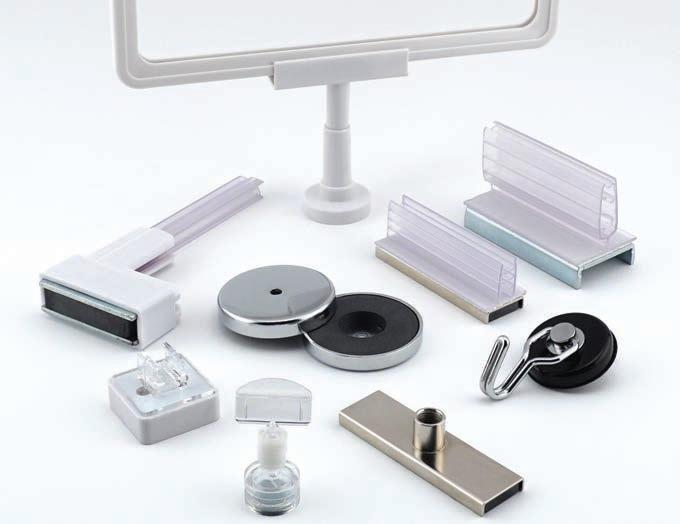
4 minute read
MAGNETIZING SIGN OPPORTUNITIES
FEATURE NAMEMAGNETS BY AUTHORBY MAURA KELLER
SIGN OPPORTUNITIES MAGNETIZING
Advertisement
Magnets have quite the pull when it comes to P-O-P displays.
According to Mike Gertz, marketing manager at magnet supplier Master Magnetics, Inc., whether used for short- or longterm applications, magnets can provide a variety of effective and simple options for point-of-purchase (P-O-P) displays. From hanging or holding signs or banners to creating full-wall, layered graphic displays, magnets are a great solution for many of these applications.
“Basically any display that requires frequently-changing information or graphics are ideal for magnets,” he says.
According to the sources interviewed, magnets are usually the simplest and most cost-effective solution for many point-ofpurchase applications. They’re easily repositionable, as well as reusable. They’re long lasting with permanent magnetism. And they’re available in a wide range of sizes and strengths to meet the specific requirements of the application.
According to Gertz, printable magnetic sheeting, magnetic-receptive sheeting, a wide variety of magnetic sign holders, magnetic hooks, and carabiners and posts are the most sought-after magnetic signage components in P-O-P these days.
“Magnetic carabiners are the ideal fastener for vinyl banners with grommets because of their strength and how easily repositionable magnets are with no need for drilling holes or other types of fasteners,” he says.
Kylie Schleicher, product manager at display solutions provider Ultraflex Systems, Inc., points out that retail signage has evolved from standard rigid substrates and traditional magnets to also include the use of magnetic-receptive graphics—printable materials that will adhere to magnets in stores.
“These graphics help solve some issues with the use of traditional magnetics, such as heavy weights for lifting and shipping,” says Schleicher. “Magnetic-receptive media is lightweight and can easily be installed by retail employees by rolling the material onto the magnet.”
What’s more, magnetic graphic systems (magnetic sheeting and magneticreceptive sheeting) are ideal for P-O-P applications because the graphics and copy can be layered, so only the variable part needs to be changed. As Gertz explains, the magnetic sheeting is available with an adhesive backing that adheres to a wall or a backer board, and the layered graphics printed on magnetic-receptive sheeting quickly and easily attracts to the magnet. “For printed graphic displays, magnetic graphics offer the same brilliant high-resolution attention-getting clarity and color as most any other printable substrate,” he says. “Installation is simple and they’re easily repositionable and reusable.”
For example, Ultraflex Systems offers its Ultraflex Signetics, which is magneticreceptive media that is easy to install in store as well as de-install.
“[This product] also allows the graphics to be layered—for instance, adding

Magnetic sign holders and hooks.

STRAIGHT TO YOUR INBOX
SBI Update, Sign Builder Illustrated’s e-newsletter, delivers the latest hot topics and news from around the sign industry right to your email.
a “Sale” graphic on top of an existing graphic or having different menus on top of one another for easy changeouts,” says Schleicher. “The material is also lightweight, which makes it easy and inexpensive to ship as opposed to the heavier rigid substrates.
“And because the product can be rolled up in a tube for shipping, or shipped flat in a small package, the material is less prone to shipping damage, where large rigid substrates can be damaged due to improper handling.”
Considerations To Make When considering incorporating magnetic components into signage applications, there are things signage professionals need to consider.
For printed graphics, understand that the topcoat printable surface of the magnet or magnetic-receptive sheeting is compatible to the ink system of the printer. Solvent, eco-solvent, UV, and latex inks can print directly to most vinyl or coated topcoats.
“However aqueous inks need to print onto a paper topcoat,” says Gertz. “And to protect it from handling or the weather, if intended to be used outdoors, they would need to be laminated.”
Sign companies should also consider if there is any plan to layer graphics. If they plan on layering graphics, the team at Ultraflex Systems suggests the use of a highenergy magnet.
“Initially sign companies need to consider what type of structure will hold the base magnet layer,” says Schleicher. “Will the magnets be permanently installed on the store walls? Or will they be mounted onto a board and installed? Or will they be used in a free-standing display?
“Once the base is determined, the use of magnetic-receptive material is simple.”
Meanwhile, for magnetic assemblies such as hooks, carabiners, or sign holders, signage professionals need to make sure the fastening end is appropriate for the sign or graphic and that the strength of the magnet is right for the application.
Conclusion As far as the future prevalence of magnets within signage systems, Gertz believes the use of magnets will continue to grow as people become more and more aware of the simplicity, versatility, and cost-efficiency that magnetic solutions provide for P-O-P and other signage areas.
Schleicher adds, “With a focus on industries cutting costs and limiting outside personnel into offices and stores, it also will be important to have office and retail employees change the graphics themselves. Magnetic-receptive materials are a great way to convey messages, menus, and seasonal signage, and [this media] can allow for messaging to be changed quickly and seamlessly.”

WHAT’S THE HOT TOPIC THIS MONTH? Sign up at www.signshop.com to receive the newsletter and find out!
fb.com/SBIMag
@SBIMag
Sign Builder Illustrated







